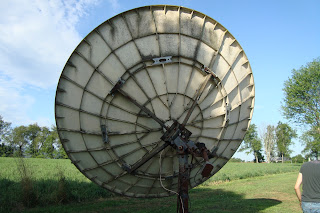We will most likely let it as is for a week or two to the wind some time to take a whack at it. During this time we plan on adusting the pivot point to make it as easy as possible for the dish to move in a way that is most accurate with the way the sun moves across the sky. I may get a weatherproof box together to store the electronics during this time as well. I'll update this post as this phase continues.
p.s. Pictures of the dish attached to the pole will come this weekend. It's HUGE!
Additionally, I cleaned up the dish with a pressure washer.
UPDATE:
I've completed attaching the dish to the post with the help of my dad and brother. We also lined it up partially and tried running the actuator. The 24v 1A dc power supply just can't cut it. I'm in the market for a 36v 3A replacement.














